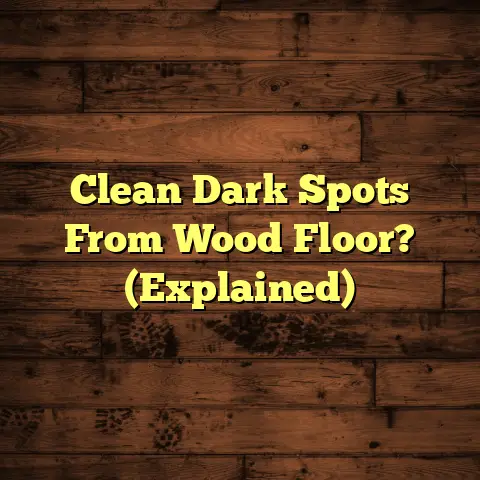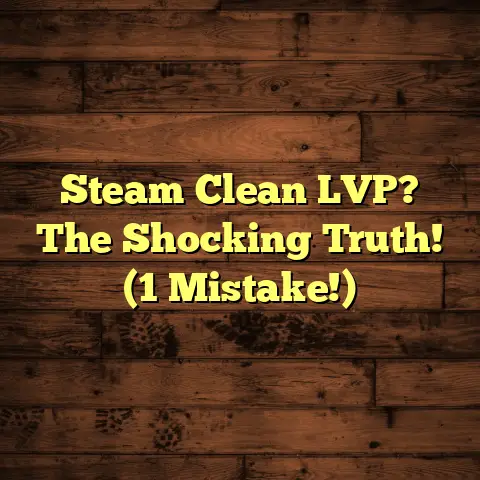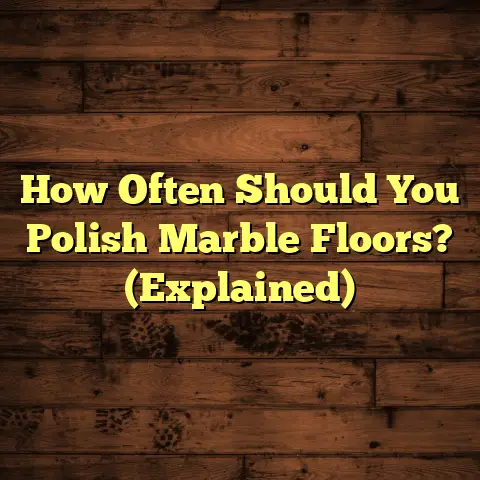Vinegar on Wood Floors? (7 Finish Fails!)
We all want a sparkling clean home, right?
And let’s be honest, those gorgeous wood floors are a major selling point.
They add warmth, elegance, and a touch of luxury.
But keeping them looking their best can feel like a constant battle.
I’ve seen it all in my years of experience.
One cleaning hack that keeps popping up is using vinegar.
It’s natural, cheap, and supposedly effective.
But is it really safe for your precious wood floors?
The short answer? It’s complicated, and often, a big NO.
Let’s dive into why that seemingly harmless bottle of vinegar could be your wood floor’s worst enemy.
Section 1: Understanding Wood Floor Finishes
Okay, let’s talk finishes.
Think of it as the protective armor for your wood.
It’s what stands between the wood itself and the harsh realities of daily life – spills, scratches, and, yes, even cleaning products.
There are several types of finishes commonly used, and each reacts differently to various cleaning agents.
- Polyurethane: This is the most common finish, and for
good reason.
It’s durable, water-resistant, and relatively low-maintenance.
You’ll find it in both oil-based and water-based forms. - Oil-Based Finishes: These penetrate the wood, providing a
rich, warm tone.
They’re durable but can yellow over time. - Wax Finishes: This is a more traditional option, offering a
soft, natural look.
However, it requires regular maintenance and isn’t as water-resistant as polyurethane. - Acrylic Finishes: These are water-based and known for their clarity and non-yellowing properties.
- Aluminum Oxide Finishes: This is a super tough, factory-applied
finish often found on prefinished floors.
It’s very scratch-resistant.
Why is this important?
Because what works for one finish could be disastrous for another.
Imagine this: You’ve got a beautiful, newly installed
polyurethane-finished floor.
You hear vinegar is a great natural
cleaner, so you whip up a batch and start mopping.
At first, things seem fine.
But over time, the acidity of the vinegar can start to dull the finish, leaving it looking cloudy and lifeless.
Now, let’s say you have an older floor with a wax finish.
Vinegar will strip that wax right off, leaving the wood exposed and
vulnerable.
I’ve seen floors go from lustrous to lackluster in a
matter of weeks because of this.
The takeaway here is simple: Know your finish!
If you’re unsure, check with the previous owner, the builder, or even a local flooring expert.
It’s worth the effort to avoid a costly mistake.
Section 2: The Science Behind Vinegar and Acidity
Alright, let’s get a little scientific.
Vinegar, at its core, is acetic acid diluted in water.
That acidity is what makes it a cleaning agent.
It can break down grime, dissolve mineral deposits, and kill some
bacteria.
But that same acidity can also wreak havoc on certain
materials, including wood floor finishes.
The pH scale measures acidity.
A pH of 7 is neutral, anything below 7 is acidic, and anything above 7 is alkaline (or basic).
Vinegar typically has a pH of around 2-3, making it quite acidic.
For comparison, lemon juice has a pH of around 2, and baking soda
(a common alkaline cleaner) has a pH of around 8.
When vinegar comes into contact with wood floor finishes, a chemical
reaction can occur.
The acid can slowly break down the protective
layer, especially if it’s a weaker finish like wax.
With polyurethane, the reaction is slower, but over time, the acidity can still dull the finish and make it more susceptible to scratches and wear.
I’ve even seen cases where the vinegar has seeped through cracks in the finish and started to damage the wood itself.
This can lead to discoloration, warping, and even rot.
Think of it like this: Imagine repeatedly scrubbing a painted wall with a mildly abrasive cleaner.
Eventually, the paint will start to fade and wear away.
Vinegar on wood floors is a similar process, just happening at a slower, more subtle rate.
Section 3: Common Misconceptions About Vinegar
Now, let’s bust some myths!
There’s a lot of misinformation out there about vinegar as a cleaning agent.
Here are a few common misconceptions I’ve encountered:
- Myth #1: Vinegar is a universal cleaner. Nope!
While it’s great for some tasks, like cleaning glass and removing hard water stains, it’s not a one-size-fits-all solution. - Myth #2: Diluted vinegar is safe for all wood floors.
Dilution helps, but it doesn’t eliminate the risk, especially with
repeated use.
The acidity is still there. - Myth #3: If it looks clean, it’s fine. Just because you don’t
see immediate damage doesn’t mean it’s not happening.
The effects of vinegar can be cumulative, showing up over months or even years. - Myth #4: My grandma used vinegar, so it must be okay.
Floor finishes have changed dramatically over the years.
What was safe for grandma’s waxed floors might be disastrous for your polyurethane finish.
I remember one homeowner who was convinced vinegar was the only way
to clean her floors.
She’d been using it for years, and her floors
looked “fine.”
However, when I inspected them closely, I noticed a subtle haziness and a lack of shine.
The polyurethane finish had been slowly degraded by the vinegar, and the floors were now much more vulnerable to scratches and stains.
She ended up needing to have them professionally buffed and recoated, a costly repair that could have been avoided.
The truth is, misinformation can be expensive.
Relying on outdated advice or unverified cleaning hacks can lead to long-term damage and costly repairs.
Always do your research, know your finish, and choose cleaning products specifically designed for wood floors.
Section 4: The Seven Finish Fails
Okay, here’s the nitty-gritty.
These are the seven specific ways vinegar can sabotage your wood floor finish:
1. Finish Discoloration
Vinegar can cause fading or discoloration, particularly on darker
wood floors.
The acidity can react with the pigments in the stain,
leading to a bleached or washed-out appearance.
I’ve seen this happen most often on floors with dark walnut or
cherry stains.
The vinegar essentially lifts the color, leaving behind
a lighter, less vibrant hue.
The discoloration might not be immediately noticeable, but over time, you’ll start to see a patchy or uneven appearance.
Areas that are frequently mopped or exposed to more vinegar will fade faster, creating an unsightly contrast.
Example: A homeowner with dark-stained oak floors used a vinegar
solution to clean up a pet accident.
Over the next few months, she
noticed a distinct lightening of the wood in that area, creating a
noticeable blemish.
2. Surface Damage
The acidic nature of vinegar can degrade or dull the finish over time, making it more susceptible to scratches and wear.
Think of your floor finish as a protective shield.
Vinegar slowly weakens that shield, making it easier for everyday wear and tear to take its toll.
Foot traffic, pet claws, and dropped objects can all cause more damage to a weakened finish.
The result is a dull, scratched, and worn-looking floor.
I often see this in high-traffic areas like hallways and kitchens.
Example: A family with young children used vinegar to clean their
kitchen floor daily.
After a year, the finish in the high-traffic
areas was noticeably duller and more scratched than the finish in
other parts of the house.
3. Water Damage
While vinegar itself is a liquid, its use can contribute to water damage.
The acidity can compromise the finish’s ability to repel water, allowing moisture to seep into the wood.
This can lead to warping, swelling, and even rot.
This is especially problematic in areas prone to spills, like kitchens and bathrooms.
I’ve seen floors buckle and warp after repeated exposure to vinegar and water.
Example: A homeowner used a vinegar solution to clean their
bathroom floor, not realizing that the grout was cracked.
The vinegar
solution seeped through the cracks and into the subfloor, causing
significant water damage and requiring costly repairs.
4. Adhesive Failure
This is a major concern for engineered wood floors.
Vinegar can weaken the adhesive bond that holds the layers of engineered wood together.
This can lead to peeling, separation, and delamination.
Engineered wood floors are made up of multiple layers of wood glued together.
The adhesive is crucial for maintaining the floor’s structural integrity.
Vinegar can break down that adhesive, causing the layers to separate and the floor to fall apart.
Example: A homeowner with engineered wood floors used a vinegar
solution to clean up a spill.
Over time, they noticed that the edges
of the planks were starting to peel and separate.
The vinegar had
weakened the adhesive, causing the layers to delaminate.
5. Wax Finish Issues
As I mentioned earlier, vinegar is a wax finish’s worst nightmare.
It strips away the wax, leaving the floor looking dull and unprotected.
Wax finishes require regular waxing to maintain their shine and water resistance.
Vinegar dissolves the wax, removing that protective layer and leaving the wood exposed.
This makes the floor more vulnerable to scratches, stains, and water damage.
Example: A homeowner with a beautiful antique floor with a wax
finish used vinegar to clean it.
The vinegar immediately stripped away
the wax, leaving the floor looking dull and lifeless.
They had to
re-wax the entire floor to restore its shine.
6. Sealant Compromise
Many wood floors have sealants applied to protect them from spills and stains.
Vinegar can break down these sealants, making the floor more susceptible to damage.
Sealants are designed to create a barrier that prevents liquids from penetrating the wood.
Vinegar can dissolve or weaken that barrier, allowing spills to seep into the wood and cause stains.
Example: A homeowner with sealed wood floors spilled red wine on
the floor and immediately cleaned it up with a vinegar solution.
The
vinegar compromised the sealant, allowing the wine to stain the wood.
They had to have the floor professionally cleaned to remove the stain.
7. Long-Term Maintenance Costs
While vinegar might seem like a cheap and easy cleaning solution, it can actually lead to higher long-term maintenance costs.
The damage caused by vinegar can require costly repairs, refinishing, or even replacement.
Think about it: a dull finish needs to be buffed and recoated.
Water damage requires repairs to the subfloor.
Adhesive failure necessitates replacing entire sections of flooring.
These costs can quickly add up, making vinegar a very expensive “cleaning” solution in the long run.
Example: A homeowner consistently used vinegar on their wood
floors for several years.
The floors became dull, scratched, and
discolored.
They eventually had to have the entire floor professionally
sanded and refinished, costing them thousands of dollars.
Conclusion
So, there you have it. The truth about vinegar and wood floors.
While it might be tempting to reach for that bottle of vinegar as a quick and easy cleaning solution, it’s simply not worth the risk.
The potential damage to your floor finish, the risk of water damage, and the long-term maintenance costs all outweigh any perceived benefits.
Remember, your wood floors are an investment.
Protect that investment by using cleaning products specifically designed for wood floors and by understanding the specific needs of your finish.
Don’t let a seemingly harmless cleaning hack turn into a costly mistake.
Educate yourself, choose wisely, and keep your wood floors looking beautiful for years to come!





